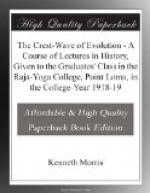“last weird battle in the west,”
when
“All day long
the noise of battle rolled
Among the mountains
by the wintry sea,
Till all King Arthur’s
Table, man by man,
Had fallen in Lyonnesse
about their lord
King Arthur.”
Now the reign of Arthur may be supposed to represent the culmination of a national revival among the British Celts; and, —this is the detail I was pleased to come upon,—according to Geoffrey, Camlan was fought in 542;—a matter of thirteen decades (and two years) after the expulsion of the Romans. So that, I say, it looks as if there were some cyclic reality behind it. Geoffrey of Monmouth did not know that such periods of national revival do last as a general rule for thirteen decades. He had some other guide to help him to that 542 for Camlan.
History knows practically nothing about fifth-century Britain. It has been looking at it, since scientific methods came in, through Teutonic (including Anglo-Saxon) or Latin eyes; and seen very little indeed but confusion. Britain like the rest of the western empire, suffered the incursions of northern barbarism; but unlike most of the rest, it fought, and not as a piece of Rome, but as Celtic Britain;—fought, and would not compromise nor understand that it was defeated. It took eight centuries of war, and the loss of all England, and the loss of all Wales, to teach, it that lesson; and even then it was by no means sure. In the twelve-eighties, when last Llewelyn went to war, he was still hoping, not to save Wales from the English, but to re-establish the Celtic Kingdom of Britain, Arthur’s Empire, and to wear the high crown of London. The men that marched to Bosworth Field under Harri Tudor, two centuries later, went with the same curious hope and assurance. It was a racial mold of mind, and one of extraordinary strength and persistence,—and one totally unjustified by facts in what were then the present and future. But I do not believe such molds can ever be fudged up out of nothing: ex nihilo nihil is as true here as elsewhere. So we must look for the cause and formation of this mold in the past. Something, I think, within that first cycle of Welsh history must have impressed it on the Welsh mind: some national flowering; some great figure, one would say.—Arthur? He is like Vikramaditya of Ujjain; no one know whether he existed at all. There is no historic evidence; but rather the reverse. But then there are all those mountains and things named after him, “from the top of Pengwaed in Cornwall to the bottom of Dinsol in the North”; and, there is the Arthurian Legend, with such great vitality that it drove out the national Saxon legends from England, and quenched the Charlemagne legend in France, and made itself master of the mind of western Europe in the Middle Ages;— I imagine there would have been an Arthur. Some chieftain who won battles; held up the Saxon advance for a long time, probably; and reminded his people of some ancient hero, or perhaps of a God Artaios, thought to be reincarnate in him.




